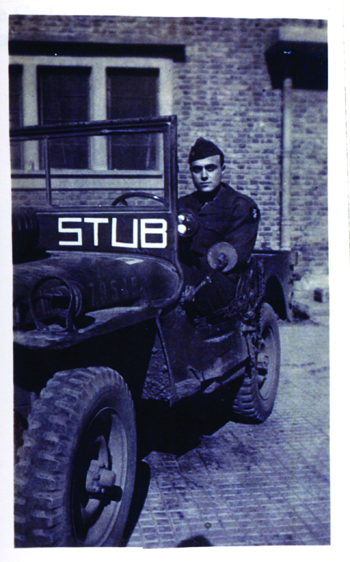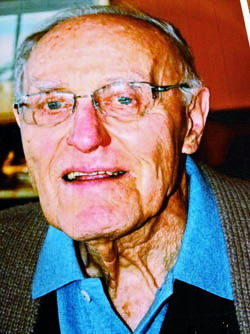Doctor on the Ship, on the Beach, and in the Trenches
Naval Medical Officer David A. Goldsmith ’38 Reminisces About the War Days

While stationed in St. Raphael, Goldsmith and his fellow officers ran a small dispensary out of an abandoned store. Treating minor injuries, hospital corpsmen from three platoons worked seven-man shifts in rotation.
Just before Labor Day 1939, David Goldsmith was out in a rowboat with his parents on Maxinkuckee Lake in northern Indiana. The family idyll was interrupted when their portable radio broadcast the news that Hitler had invaded Poland, sparking the start of World War II. At the time, Goldsmith was a student at Northwestern University Medical School.
“Everyone had to sign up for the draft,” he writes in A Navy Medical Officer in World War II, one of two self-published memoirs Goldsmith, age 95, has written during the last three years. Commissioned as an officer in the Navy Medical Corps, he trained for three months along the East Coast and shipped out with the 8th Beach Battalion on the Liberty Ship S.S. Robert H. Harrison, a nonmilitary Merchant Marine ship in a 100-vessel fleet bound for North Africa.
“We were at sea for three weeks, in a cabin with five triple-deck bunks,” Goldsmith says. “Fifteen men in a small, very warm cabin. I was in the middle bunk, and the fellow above me was seasick for two of the three weeks. The showers were salt water, so you couldn’t make any lather.”
It was a frightening time for everyone. “We were in complete blackout the whole time. We never went on deck, because if one fell overboard, they wouldn’t stop the ship to pick you up or look for you,” Goldsmith says. “Those weeks were rough.”
In early May, the ship entered the Mediterranean through the Straits of Gibraltar and arrived in the port of Arzew, Algeria. “We learned that our convoy, which had continued to travel east after our ship left it, was bombed by a German plane,” Goldsmith says.
After a time of training maneuvers and practice landings in the Mediterranean, Goldsmith and his battalion traveled by Navy transport ship to Naples, Italy, and then by truck to Salerno. They bivouacked on a beach that was blanketed with ash from a recent eruption of nearby Mount Vesuvius. In late July, they moved, again by truck, to a small town just north of Naples, where they were attached to the 48th Army Engineer Battalion.
In the meantime, preparations were under way for the Aug. 15 landing—“Operation Dragoon”—on the beach in southern France. “We sailed on August 10 toward France going between Corsica and Sardinia,” Goldsmith writes. They were stationed on the beach near St. Raphael.

David Goldsmith ’38, recalls his war days vividly in his self-published books.
On Aug. 15, the battalion participated in the Camel area assault on the coast of southern France. The beach came under attack from enemy small arms and shellfire. From a position on a hill, they saw a German bomber strike a tank landing ship (LST) whose personnel, preparing to land, were all below deck. They had no chance to escape. Six of Goldsmith’s own battalion were wounded during the assault.
Six weeks later, the battalion was transported in Navy personnel ships across the Mediterranean back to the north coast of Africa, this time to Bizerte, a town in Tunisia. They remained there for several weeks before the battalion sailed with a convoy of LSTs on a sometimes very rough, five-week Atlantic Ocean voyage back to the United States. “We anchored the last night near the Statue of Liberty and landed the next day at the Brooklyn Navy Yard,” Goldsmith says.
In his three years as a naval medical officer, Goldsmith fulfilled further tours in Hawaii, the Marshall Islands, Guam, and China. He was released from active duty in October 1946 but continued to earn Navy credits as a medical officer in Naval Reserve units in Anderson and Muncie, Ind. He and his family settled in Marion, Ind., where he served until his retirement in 1986 as chief of medical services for the Veterans Administration.
 Email This Page
Email This Page